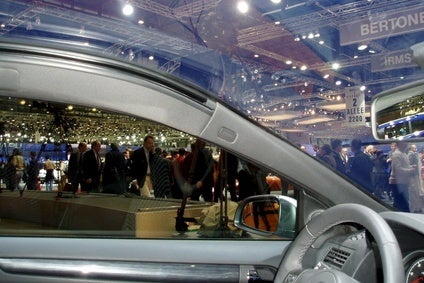
Continuing just-auto’s series of research snapshots – pulled from its automotive research platform, QUBE – Matthew Beecham reviews some value-added glazing products, including acoustic windscreens, infrared reflective windscreens, laminated side glass, polycarbonate and ever thinner glazings. But are these features really just solutions looking for problems?
Acoustic windscreens
Noise reduction inside cars and consequently improvement of acoustic control has long since been a focus of automakers. Yet the vehicle’s glazed surface is continuously increasing making it a significant path for noise penetration inside the car. For example, the Citroën C4 has the largest glazed roof in its class (7.55 m² in total with 2 m² accounted for by the panoramic windscreen). Compared with the Citroën Xsara Picasso model, which itself carries 6.67 m² of glass, an additional 13.2 percent of glass has been added to the C4 Picasso. An acoustic windscreen, however, can lower the sound levels entering the cabin by as much as five decibels using a specially designed acoustic insert between two PVB films. This sandwich is then inserted between the windscreen’s two sheets of glass. Since the first vehicle appeared in Europe with an acoustic windscreen – the Renault Clio II – the number of vehicles being fitted with acoustic glazing is gradually increasing.
Infrared reflective windscreens
Infrared reflective (IRR) windscreens are used to enhance thermal comfort and increase air conditioning efficiency. A number of glassmakers offer this type of coating, marketing it under various guises. For example, Pittsburgh Glass Works’ (PGW) Sungate windscreens are produced from two pieces of glass with a vinyl interlayer sandwiched between. The outer glass has a transparent metallic coating that reflects solar infrared heat while transmitting visible light. As a result, Sungate windscreens reflect about 50 percent of the solar energy striking the glass. The aesthetics of the coating can be changed to give it more or less colour to coordinate with the vehicle’s paint work. PGW further claims that tests have proved that installing Sungate can increase a vehicle’s fuel efficiency by up to four percent.
In observing demand for IRR glazing, Pete Dishart, PGW told just-auto: “In Europe [IRR windscreens] were launched on smaller vehicles back in the days when air conditioning was not so prevalent. The heat load reduction was therefore a very effective way of dealing with passenger comfort in a car that didn’t have air conditioning. Today, we see it being offered in all car segments. The major difference between the upscale ones and the lower segment cars is that in the upscale segments they are offering IRR glazings in all locations around the car. For example, Mercedes-Benz S Class and Audi A8 have IRR glazing in all positions – windscreens, doors and backlites; that itself is not very common in lower segments cars.”

US Tariffs are shifting - will you react or anticipate?
Don’t let policy changes catch you off guard. Stay proactive with real-time data and expert analysis.
By GlobalDataLaminated side glass
Every car has a laminated windscreen, of course. For some time, however, Europe has led with the adoption of laminated side glass for increased vehicle comfort and security. The first North American vehicle with laminated side windows was launched in 2002 with market demand catching-up Europe. Today, we are seeing a clear upward trend for laminated side glass, especially for front door applications due to the acoustical benefit that comes with that value-added product.
Polycarbonate glazing
Interest in polycarbonate (PC) automotive glazing is gradually gaining momentum. Compared to the shape limitations of glass, PC glazing is highly versatile, lighter with high impact resistance. Suppliers of the material claim that a total weight reduction of more than 20kg (50 percent) is possible when replacing all glass windows (except the windscreen) for a standard minivan. Although PC glazing has been showcased on a number of concept vehicles, its appearance on production cars is still limited. For instance, the material is fitted on the fixed rear side windows adjacent to an aerodynamic spoiler on the Fiat 500L, creating one seamless part.
Thinner glazings
The quest for thinner and lighter glazings continues. The standard thickness of a windscreen in Europe some years ago was about 4.2mm (i.e. 2.1mm plus 2.1mm) whereas today we are seeing 3.6mm on certain models. Glass manufacturers tell us that by shaving off 1mm total thickness typically results in a two kilo weight saving which, of course, leads to a CO² reduction.
Toyota claims that its i-Road ‘ultra-compact mobility package’ concept features the thinnest glass ever used for a car windscreen. Manufactured by NSG Group, the screen is made from laminated glass with a 2mm outer layer, interlayer and 1mm inner layer. The supplier said the screen is lighter than usual and helps reduce overall vehicle weight and therefore helps improves efficiency and reduce CO2 emissions. It is 23 percent lighter compared with a conventional design currently produced.
Finally, there are some who argue that such added value glazing products described here add cost at a time when automakers are looking for cuts. So are these features really just solutions looking for problems? We don’t think so. In a lot of cases there are problems out there that need solutions. If we look back at the overall trend in terms of quiet vehicles and improving acoustics alone, that is an area where clearly there is a problem in need of a solution. While some may say that that has always been out there, the difference is that the expectations of consumers is continually growing and evolving in acquiring a quieter vehicle.



